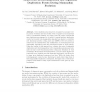Free Online Productivity Tools
i2Speak
i2Symbol
i2OCR
iTex2Img
iWeb2Print
iWeb2Shot
i2Type
iPdf2Split
iPdf2Merge
i2Bopomofo
i2Arabic
i2Style
i2Image
i2PDF
iLatex2Rtf
Sci2ools
RECOMB
2008
Springer
2008
Springer
Estimating the Relative Contributions of New Genes from Retrotransposition and Segmental Duplication Events during Mammalian Evo
Gene duplication has long been recognized as a major force in genome evolution and has recently been recognized as an important source of individual variation. For many years the origin of functional gene duplicates was assumed to be whole or partial genome duplication events, but recently retrotransposition has also been shown to contribute new functional protein coding genes and siRNA's. Here we present a method for the identification and classification of retrotransposed and segmentally duplicated genes and pseudogenes based on local synteny. Using the results of this approach we compare the rates of segmental duplication and retrotransposition in five mammalian genomes and estimate the rate of new functional protein coding gene formation by each mechanism. We find that retrotransposition occurs at a much higher and temporally more variable rate than segmental duplication, and gives rise to many more duplicated sequences over time. While the chance that retrotransposed copies b...
Computational Biology | Partial Genome Duplication | Protein Coding Genes | RECOMB 2008 | Segmental Duplication |
| Added | 03 Dec 2009 |
| Updated | 03 Dec 2009 |
| Type | Conference |
| Year | 2008 |
| Where | RECOMB |
| Authors | Jin Jun, Paul Ryvkin, Edward Hemphill, Ion I. Mandoiu, Craig Nelson |
Comments (0)

